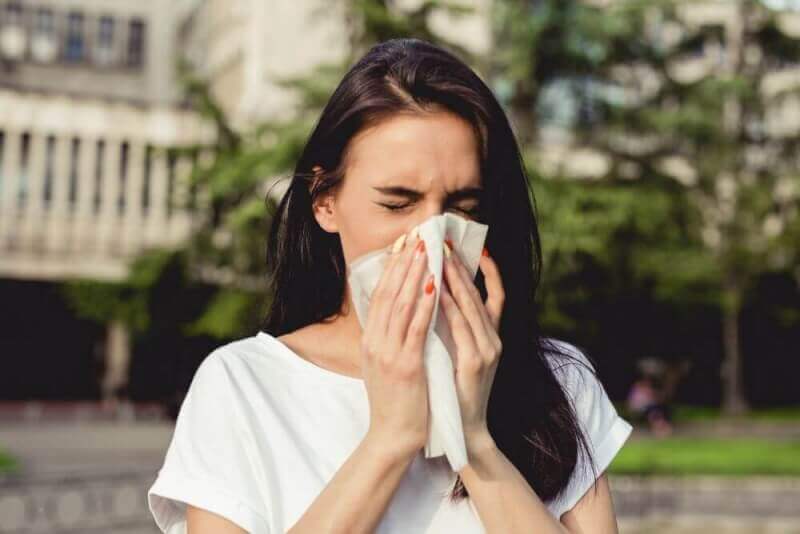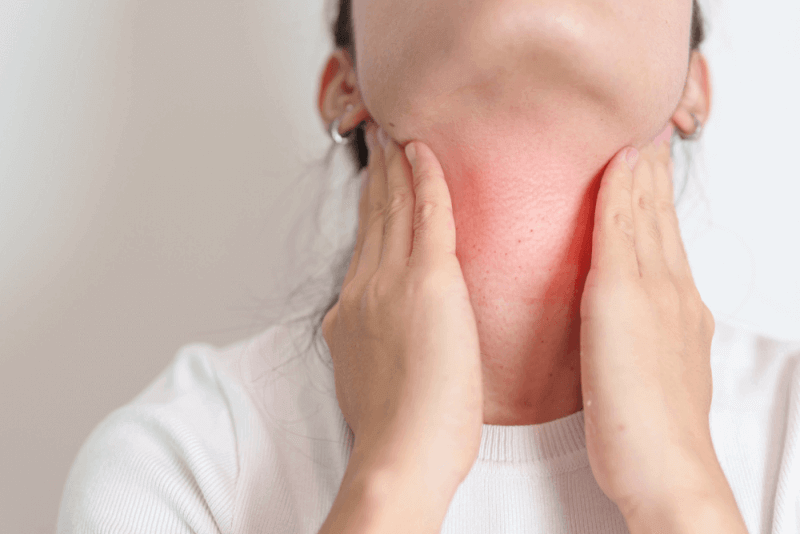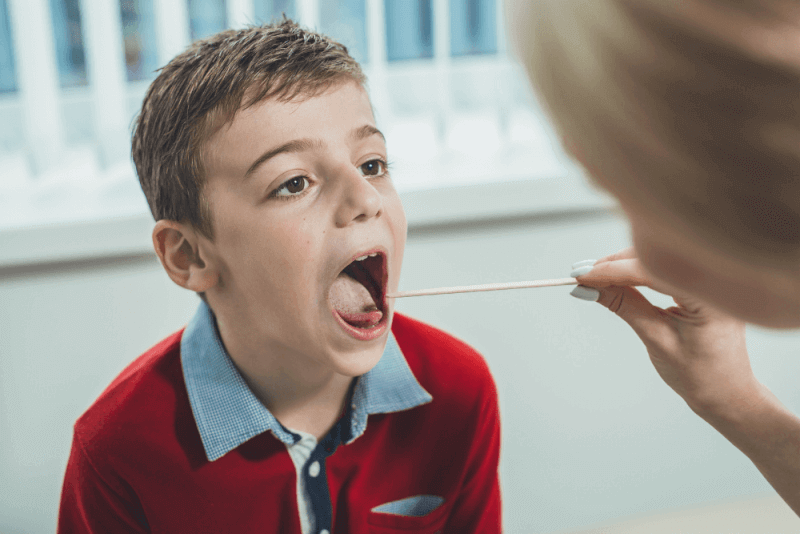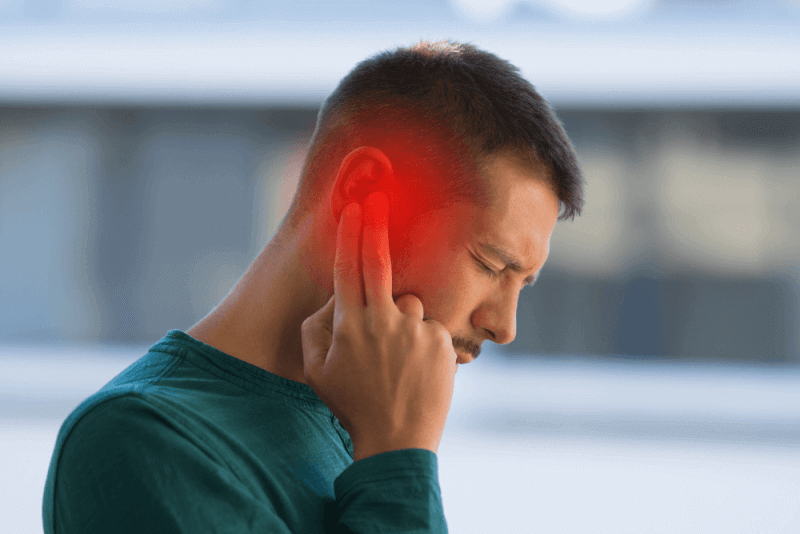What is an allergy?
Basically, an allergy is a reaction of the immune system to a foreign substance such as pollen, pets, insects or food that would not cause any problems for most people. The immune system produces substances called antibodies to eliminate foreigners entering the body. In allergic cases, the immune system also produces antibodies for allergenic substances, although it does not cause any health problems. This is why the sinuses, skin or digestive system react to contact with the allergen. The severity of allergies varies between people. Although some people have mild symptoms, others develop serious conditions, including anaphylactic shock. Allergy treatment is aimed at alleviating the symptoms caused by allergies.
What is allergic asthma?
Allergy combined with a respiratory condition called asthma is called allergic asthma. Asthma is a lung disease that causes the following symptoms in the airways.
- Swelling or irritation of the airway lining
- Larger and thicker mucus production than normal
- Narrowing of the airway due to contraction of the muscles around the airways
The causes of asthma are unknown. In allergic asthma, however, it is exposure to allergens that causes asthma symptoms. When symptoms are severe, it is called an asthma attack. Possible allergens that can trigger allergic asthma include the following.
- Pets
- Pollen
- Mold
- Dust mites
- Cockroaches
Symptoms that can be seen in allergic asthma patients include the following.
- Feeling short of breath
- Frequent cough, especially at night
- Whistling sound during breathing
- Feeling of tightness in the chest
These symptoms can be severe. People with severe symptoms should have a treatment plan. In addition, allergy symptoms are less severe than asthma symptoms and include the following.
- Nasal congestion
- Rash and hives
- Itchy and runny eyes
- Sneezing
What is spring allergy?
With the increase in pollen population in spring, symptoms of spring allergy begin to appear. When allergens enter the respiratory systems of people with spring allergies, the immune system is turned upside down. As with other types of allergy, the immune system sees pollen as a danger and is therefore activated, causing various symptoms. Symptoms that can be seen in spring allergy include the following.
- Dark circles under the eyes
- Itchy nose and eyes
- Coughing
- Sneezing
- Eye watering
- Nasal congestion
Antihistamines and decongestants are used to relieve the symptoms caused by spring allergy. Nasal sprays and eye drops also help relieve symptoms.
Allergy symptoms
Depending on the allergen, allergy symptoms can affect the sinuses, respiratory tract, skin or digestive system. Symptoms vary from mild to severe. When allergens are encountered, the IgE chemical secreted by the immune system causes the airways to narrow, making breathing difficult.
Symptoms of allergic rhinitis
Symptoms that can be seen in case of encountering allergens that cause the respiratory tract to be affected include the following. Sneezing
- Itching in the nose, roof of the mouth and eyes
- Runny nose
- Nasal congestion
- Watery, red and swollen eyes
Food allergy
Symptoms that can be seen in people with food allergies include the following.
- Tingling in the mouth
- Anaphylaxis
- Swelling of the lips, tongue or throat
- Hives
Insect sting allergy
Among the allergic symptoms that can be seen in people after insect bites are the following.
- Large area of swelling at the site of the insect bite
- Anaphylaxis
- Cough
- Tightness in the chest
- Wheezing
- Shortness of breath
- Itching or hives on the body part
Drug allergy
Symptoms that can be seen if the person is allergic to the drug include the following.
- Anaphylaxis
- Hives
- Wheezing
- Swelling of the face
- Rash
- Itchy skin
Atopic dermatitis
Symptoms that can be seen in case of atopic dermatitis, an allergic skin condition also called eczema, include the following.
- Itching
- Red
- Flakes or peel
Anaphylaxis
Anaphylaxis, the most severe of allergic reactions, causes people to go into shock and is life-threatening. Symptoms that can be seen in anaphylaxis include the following.
- Nausea
- Vomiting
- Fast pulse
- Weak pulse
- Dizziness
- Skin rash
- Severe shortness of breath
- Decline in blood pressure
- Loss of consciousness
Causes of allergy
Allergy is when the immune system mistakes a substance that is not normally dangerous for a dangerous invader. The immune system therefore produces antibodies against allergens. When exposed to the allergen, these antibodies cause the release of certain immune system chemicals, such as histamine, which cause allergy symptoms.
Common allergens are the following.
- Airborne allergens such as pollen, animal dander, mold and dust mites
- Various foods, especially peanuts, soy, wheat, shellfish
- Stings from insects such as bees
- Various medicines, especially penicillin or penicillin-based antibiotics
- Substances such as latex that cause an allergic reaction
Allergy complications
It is possible to see some health problems in people with allergies. These health problems include the following.
Anaphylaxis
In people with severe allergies, severe reactions caused by the allergy cause anaphylaxis. The most common allergens that cause anaphylaxis include medicines, foods and insect stings.
Asthma
Respiratory symptoms in people with allergies affect breathing. This increases the risk of developing asthma. It is usually triggered by exposure to an allergen in the environment.
Sinusitis, ear or lung function
People with hay fever and asthma are particularly prone to these conditions.
Allergy test
A number of tests are used to determine whether allergies are present and to which allergen the person is reacting. However, before this, details about the symptoms should be learned and a physical examination should be performed. Among the tests that can be done for allergies afterwards are the following.
Skin test
For the skin test, the skin is punctured with small amounts of proteins containing common allergens. People with allergies will experience swelling at the site of the allergen. People do not feel any pain during the skin test.
Blood test
The blood test measures the antibodies that cause the allergic reaction. For this purpose, IgE (slgE) blood tests called radioallergosorbent tests (RAST) or ImmunoCAP tests are performed. The blood sample is also tested for possible allergens.
How is allergy testing done in infants?
The skin prick test is the most preferred test option for detecting allergies and allergens in infants. It is preferred because it is the simplest method of determining whether there is an allergic reaction in babies and because it is a safe procedure for babies.
Which department performs the allergy test?
Allergy tests are performed in the allergy and immunology unit. In health facilities where this unit is not available, an internist or a pediatrician can also administer the tests.
Allergy treatment
Allergy treatment helps to control the reactions caused by allergens. Treatment options that can be applied for this purpose include the following.
Avoidance of allergens
The most effective way to avoid allergic reactions is to avoid contact with allergens. But this is not always possible. For this reason, various medical treatment options should also be planned.
Medicines
Depending on the type of allergy, some medicines help to reduce the immune system reaction. Medicines such as tablets, nasal sprays and eye drops are used for this. These medicines are available with and without a prescription.
Immunotherapy
Allergen immunotherapy may be recommended in severe allergic conditions or when other treatment options have no effect. For immunotherapy, injections of purified allergens are usually given over several years. Sublingual tablets can also be used in immunotherapy, especially for the treatment of pollen allergies.
Emergency epinephrine
People with severe allergic reactions need an emergency injection of epinephrine. This ensures that the patient's condition remains under control until severe allergic reactions require medical intervention.
Types of allergies
Differentiation of allergens leads to differentiation of allergies. Common types of allergies include the following.
Food allergy
Food allergy is more common in men than in women. Even breastfed babies may experience allergic symptoms due to allergens that pass through breast milk. People with food allergy may have allergic reactions to more than one food. Peanuts are the most common food allergen. In addition, the most common foods that cause allergies in the society include the following.
- Cow milk
- Fish
- Eggs
- Nuts from trees
- Shellfish
- Soya
- Wheat
Symptoms caused by food allergies can develop suddenly and can endanger a person's life. In addition, especially in breastfed babies, symptoms such as hives and rashes can be seen after the mother consumes cabbage, spices or carbonated drinks. These are not considered allergic reactions.
Skin allergy
In skin allergies, symptoms against allergens manifest themselves as skin reactions.
Dust allergy
The most characteristic symptom in people with dust allergy is sneezing. In addition, many different symptoms can also be seen.
Pollen allergy
If allergic symptoms increase during certain seasons, it is possible to speak of pollen or seasonal allergy.
Latex allergy
An allergic reaction to natural rubber latex is called latex allergy. Materials using natural latex include gloves, condoms and balloons. Latex allergy is a type of allergy that poses a serious health risk.
Allergic rhinitis
Allergic rhinitis, the most common type of allergy, causes nasal congestion and runny nose. In addition, the eyes, mouth and skin often itch.
Insect allergy
In people with insect allergy, allergic reactions can occur not only after insect bites but also after contact with insects. The most common insect allergens include the following.
- Bees
- Wasps
- Fire ants
- Cockroaches
- Insect-like dust mites
Dust mites and cockroaches are the biggest cause of year-round allergies and allergic asthma.
Drug allergy
Drug allergies are one of the rare types of allergy. A significant proportion of reactions to medicines should not be caused by drug allergies. The diagnosis of drug allergy is usually based on the patient's medical history and symptoms. In some cases, a skin test may also be necessary to diagnose drug allergy.
Mold allergy
Allergic reactions caused by mold and fungi. Since mold and fungi can be found both indoors and outdoors, year-round symptoms are observed.
Pet allergy
Allergies to furry pets are among the most common allergies. It is also important to know that there is no dog or cat breed that does not cause allergies.
What is good for allergies?
In addition to medical treatment options, home remedies can also be effective in relieving the symptoms caused by allergies. For this, especially foods that will support the immune system can be used.
Yogurt and live cultured foods
Such foods, which contain good bacteria, hold promise for the prevention and treatment of allergies. In addition, supporting the gut microbiota with good bacteria supports the immune system.
Turmeric
Curcumin in turmeric can stop the production of inflammatory molecules. A study on this topic suggests that daily consumption of turmeric may reduce the symptoms of allergic rhinitis.
Apple
Consuming an apple a day helps relieve allergic symptoms. The quercetin found in apples is also found in grapes, cabbage, onions, tea and tomatoes. It also has antioxidant, antiviral and anti-inflammatory properties.
Fish
Omega 3 fatty acids help protect against inflammatory conditions such as allergies. Omega 3 fatty acids are found in salmon and tuna, but also in walnuts and flaxseed.
Nuts
Magnesium-rich nuts help reduce stress and inflammation. It also helps regulate blood pressure, nerve conduction and insulin metabolism. Other foods rich in magnesium include fish, legumes, fruits, seaweed and wheat bran.
Orange
Vitamin C in oranges strengthens the immune system. Other foods rich in vitamin C include strawberries, broccoli and red peppers.
Honey
Honey strengthens the immune system against pollen. For this reason, it provides pollen tolerance for people with seasonal allergies.
Other methods that can be used to alleviate the symptoms caused by allergies include the following.
Saline solution
Washing the sinuses with saline solution provides a quick and effective opening of nasal congestion. By clearing the mucus, allergens can also be removed from the nose.
Water consumption
Care should be taken to consume enough water during the day. Otherwise, the effects of a chemical called histamine affect more.
Use of HEPA filters
Especially for people with pollen and dust allergies, using air purifiers with HEPA filters to maintain the cleanliness of indoor air helps alleviate symptoms.
Showering when coming from outside
Allergens in the external environment can enter the internal environment through clothing, skin and hair. To prevent this, it is recommended to change clothes immediately, leave shoes outside and take a shower.
Mask use
It is especially recommended that people with dust allergies use masks when doing housework or gardening. This can prevent allergens from entering the respiratory tract.
Steam bath
Blocked noses can be easily opened with steam from warm water. To do this, the head is bent over a bowl of warm water and covered with a towel.
What is good for allergy itching?
It is recommended to use creams that soften and cool the skin to relieve itching caused by allergies. Short-term use of over-the-counter corticosteroids may reduce itching. In addition, cooling creams containing camphor or menthol also relieve itching. In addition, there are also the following things that can be done.
- Scratching the itchy area should be avoided.
- Washing with warm water
- Adding epsom salt, baking soda or oat-based bath products to the warm water bath
- Stress reduction
- Oral allergy medicines
- Use of moisturizers
- Getting enough rest
What is good for pollen allergy?
In order to reduce the symptoms caused by pollen allergy, pollen exposure must first be reduced. The steps to be taken for this are as follows.
- Should stay at home in the morning hours
- Avoid mowing the lawn and stay indoors when mowing.
- Windows of the house and vehicles should be kept closed.
- During the pollen season, you should avoid staying in parks and gardens as much as possible.
- Sunglasses are recommended for eye protection.
- Plants that will not trigger pollen allergy should be preferred around the house.
In addition, antihistamines and decogestants also help to alleviate symptoms. Natural remedies can also be used to relieve the symptoms of pollen allergy. These methods have not yet been conclusively proven to be effective.
Mint tea
In addition to the refreshing effect of peppermint oil, peppermint tea with its anti-inflammatory properties is one of the best options for spring allergy. It has an effect especially in cases of nasal itching, congestion and discharge and shortness of breath.
Black cumin
It is one of the powerful antioxidants due to its abundant vitamin E content. It is recommended to be consumed daily.
Apple cider vinegar
Apple cider vinegar, which strengthens the immune system, helps relieve nasal congestion and throat discomfort caused by spring allergies. It is recommended to consume it with a spoonful of apple cider vinegar added to a glass of warm water.
Green tea
Green tea makes people feel more energetic by relieving the feeling of fatigue and exhaustion caused by spring allergy.
What is good for sun allergy?
In addition to medical treatments that can be used to alleviate symptoms for people with sun allergy, people should also pay attention to the following points.
- Reducing the time spent under the sun in spring and summer
- Avoiding going out during the peak hours of the sun.
- Medicines and products that increase sensitivity to sunlight should not be used.
- Use the necessary clothing to block the effects of the sun's rays.
- Use of sunscreen
Among the home recipes that cure sun allergy are the following.
Yogurt
Especially after sunburns, yogurt applied to the skin provides support to the skin. This strengthens the thinning skin barrier and nourishes the skin.
Pumpkin seed oil
Pumpkin seed oil, which provides natural protection against sun allergy, contains vitamins B and C. It is recommended to apply it especially on sun exposed areas at one day intervals.
Vegetable oils containing zinc
Zinc provides relief of skin sensitivity. For this reason, the use of natural oils containing zinc ensures that the blisters disappear in a short time.
What is good for eye allergy?
Eye drops are the most effective method for relieving the symptoms caused by eye allergy. In addition, the methods that are good for eye allergy include the following.
- Artificial tears
- Allergy vaccines
- Corticosteroids
- Damp cloth compress
- Tea compress








